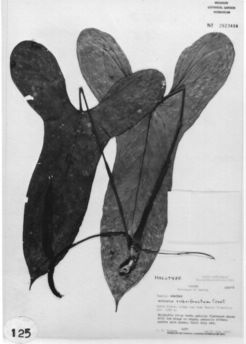




Anthurium rubrifructum Croat, sp. nov.
Type Panama. Darien: Cerro Pirre, ridge top near Rancho Plastico, 1,200 m, Folsom 4287 (MO 2623494, holotype).
Planta scandens epiphytica; cataphyllum findens in fibris tenuibus; petiolus complanatus adaxiale marginibus acutibus, 23-24 cm longus; lamina subcoriacea, triangulata, poslicis lobis hastatis, basi profunde cor-data, 31-36.5 cm longa, 19-20 cm lata; inflorescetia foliis breviore; pedunculus costatus, ca. 11.5 cm longus; spatha membranacca, pallide viridis, anguste lanceolata, 10.5 cm longa, 1.1 cm lata; spadix 4-4.5 cm longus (forte laesus); baccae rubrae.
Scandent epiphyte; stem ca. 1 cm diam.; internodes 1-1.2 cm long; cataphylls 11 cm long, weathering to fine fibers, ultimately deciduous.
LEAVES with petioles 23-24 cm long, flattened adaxially with sharp margins; geniculum ca. 1 cm long; blades triangular, conspicuously hastate lobed, drying subcoriaceous, long acuminate at apex, deeply lobed at base, 31-36.5 cm long. 19-20 cm wide, broadest near base; anterior lobe 23-26 cm long, the margins convex near apex, weakly constricted toward the base; posterior lobes 11.2-12.5 cm long (from apex of sinus to outermost point), 6-6.5 cm wide, directed outward from petiole; both surfaces matte (dry), the lower surface much paler; midrib scarcely raised above, raised below; basal veins 5-7 pairs, the first free to the base, those remaining coalesced 1.3-2.5 cm, prominulous above, raised below; primary lateral veins 8-10 per side, straight to collective vein, prominulous above, raised below, lesser veins conspicuous on drying; collective vein arising from one of the lowermost basal veins, loop-connecting the preceding basal veins and the primary lateral veins, 3-4 mm from margin, flat to scarcely raised above, raised below.
INFLORESCENCE shorter than leaves; peduncle ribbed, ca. 11.5 cm long; spathe moderately thin, pale green, narrowly lanceolate, 10.5 cm long, 1.1 cm wide, acuminate at apex, spadix not seen at anthesis.
INFRUCTESCENCE with spadix 4÷4.5 cm long (possibly damaged), 7 mm diam. near base, 4 mm diam. near apex; berries red. Fig. 125.
Anthurium rubrifructum is known only from the type locality in Panama in Darien Province on Cerro Pirre in lower montane wet forest at 1,200m. It is also expected to occur in Colombia.The species is placed with reservation into section Xialophyllium. It is placed here largely because of its viney habit. Perhaps it will prove to be aligned with section Belolonchium or a totally new sectional grouping.
It is recognized by its scandent habit, its D-shaped petioles, and by its more or less panduriform leaf blades with the posterior lobes longer than broad and projecting outward at about 130° angle from the midrib. Also characteristic are its ribbed peduncles, its green oblong-lanceolate spathe, and its red berries.
The species is not easily confused with any other in Panama. Anthurium panduriforme may have a similar leaf shape but its blades dry a light golden green color, are markedly glossy, and have many more primary lateral veins. In contrast, those of A. rubrifructum dry dark olive brown and are not markedly glossy.

Darien: Cerro Pirre, Folsom 4287 (MO), Hartman ft al. 4481 (MO).